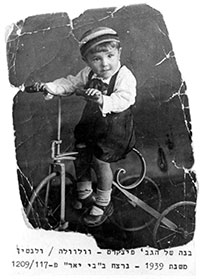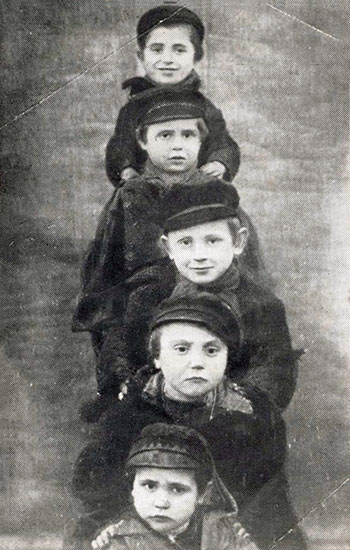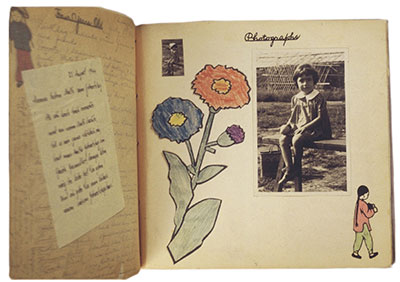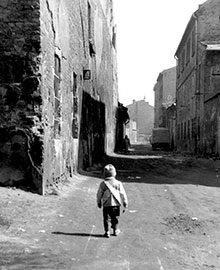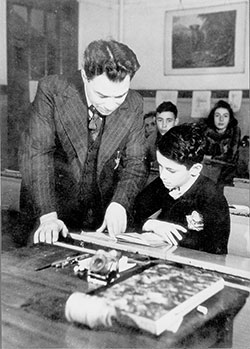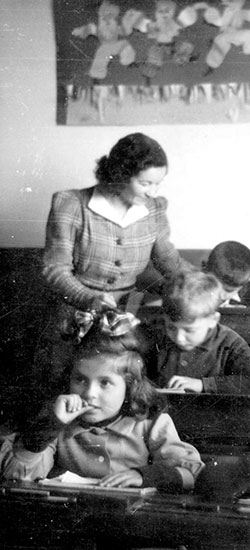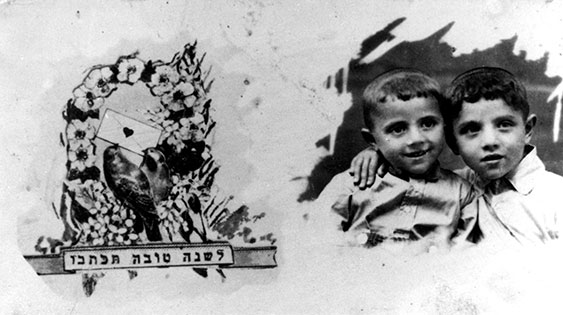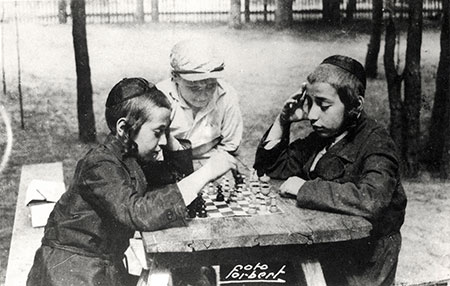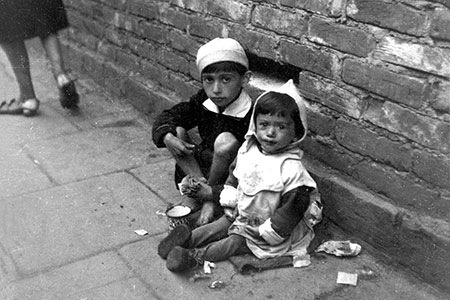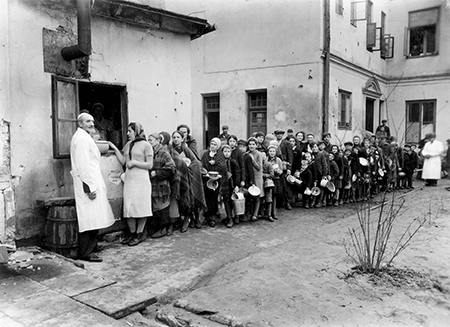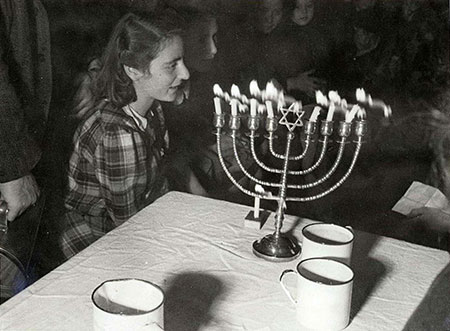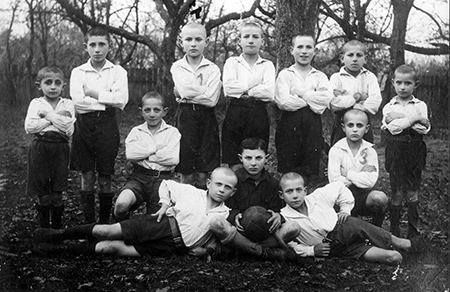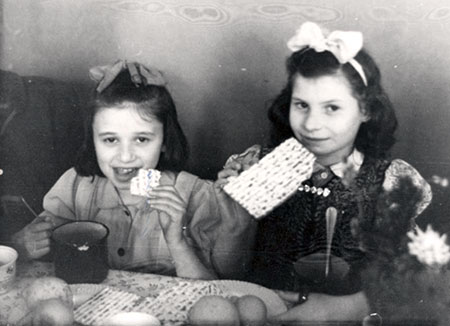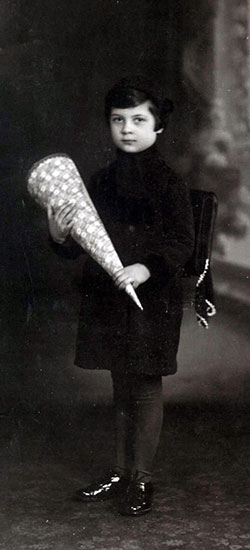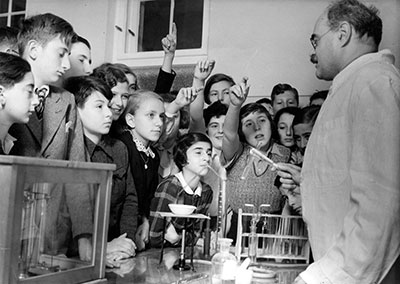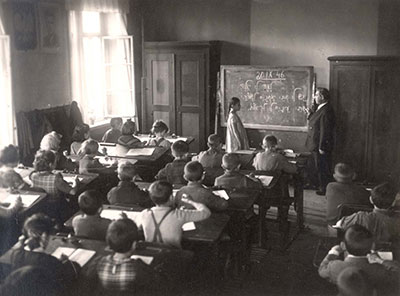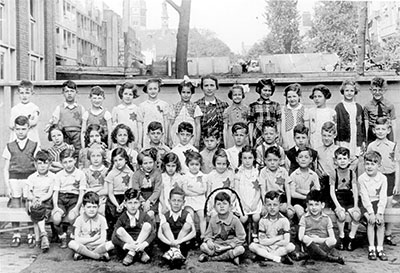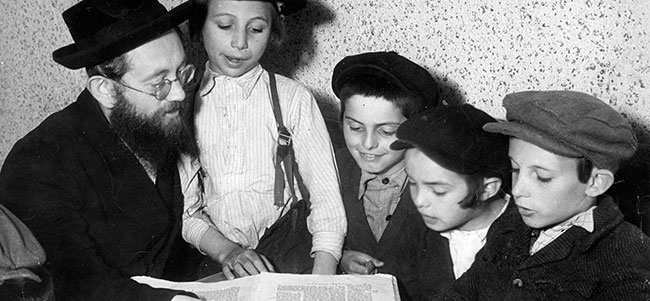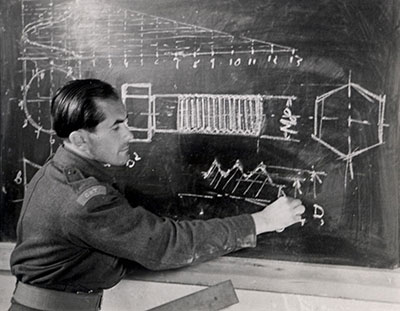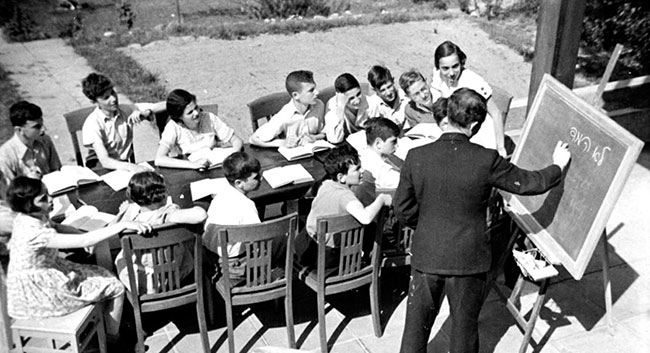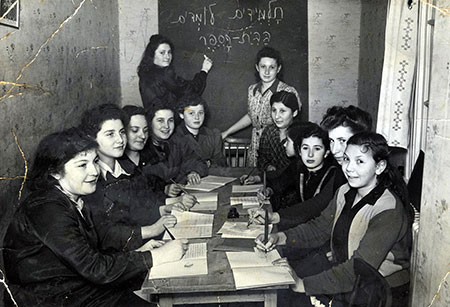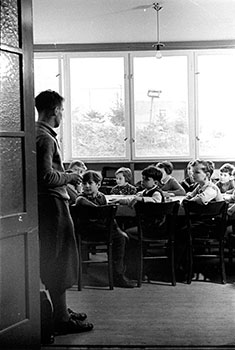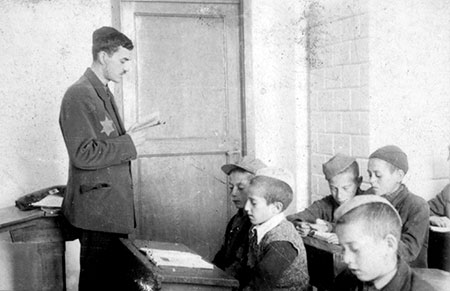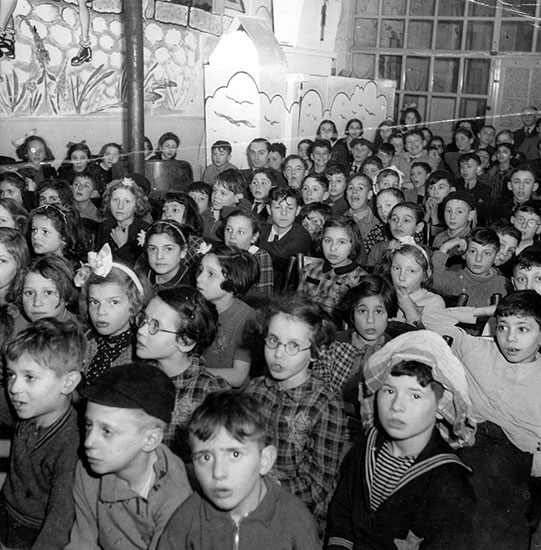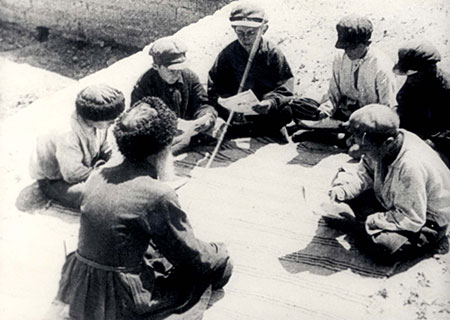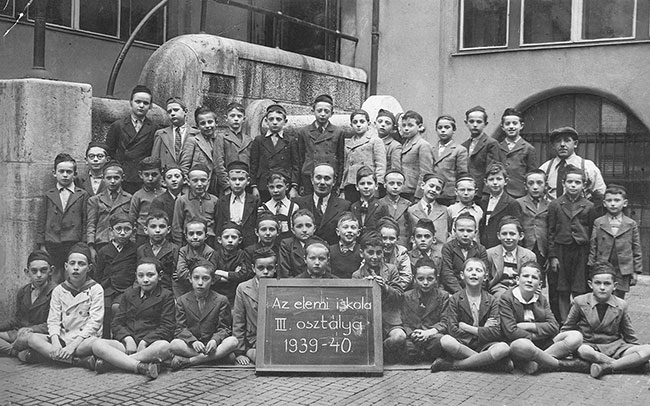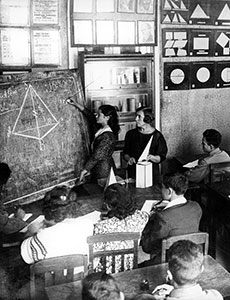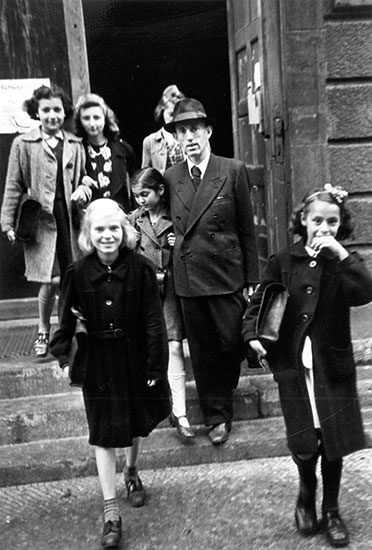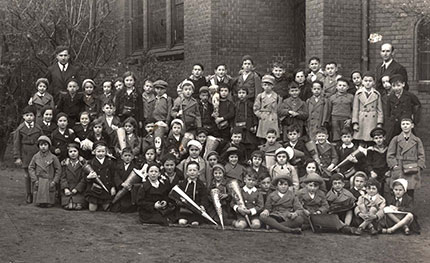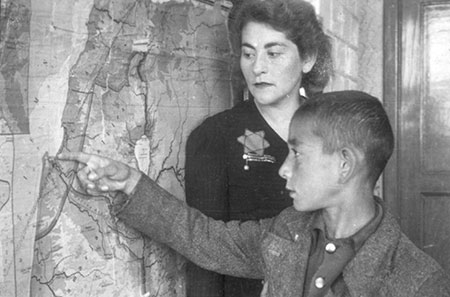Dear diary, from now on I’m imagining everything as if it really is a dream. [..] I know it isn’t a dream, but I can’t believe a thing. [..] Nobody says a word. Dear diary, I’ve never been so afraid” Eva Heyman age 13
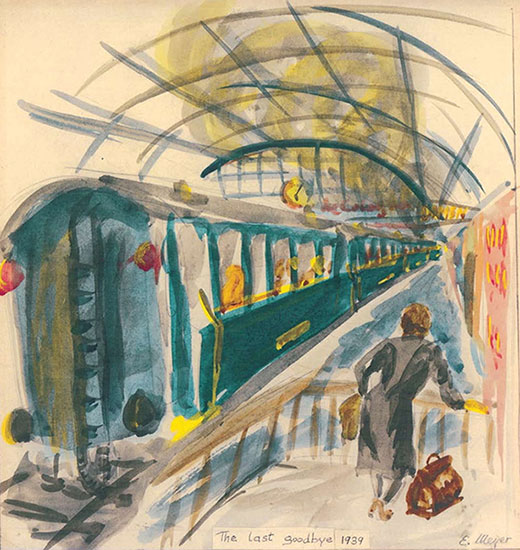
Ernest (Ernie) Meyer
The Last Goodbye, 1939

Toy boat sent from the Pithiviers camp to Jean Pojzman in Boulogne-Billancourt, France
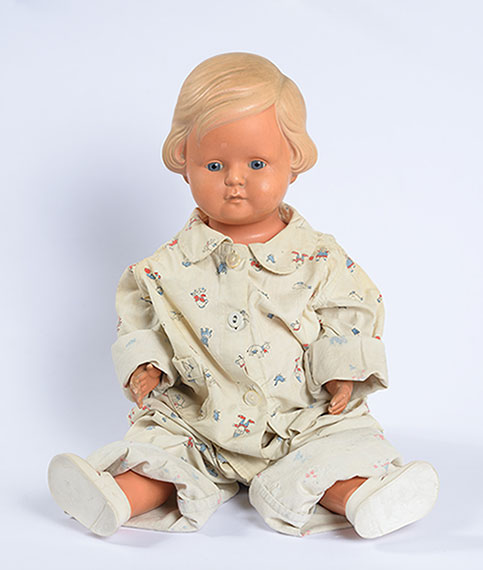
Lore Stern's doll Inge, dressed in the pajamas Lore wore when she went into hiding during Kristallnacht

The teddy bear belongs to Fred Lessing, a child survivor of the Holocaust

Stefa Fromer (left) and Jasia Gandz (right) in the children home in Otwock, Poland, after the war

Janusz Korczak with the orchestra of the children’s home in Warsaw
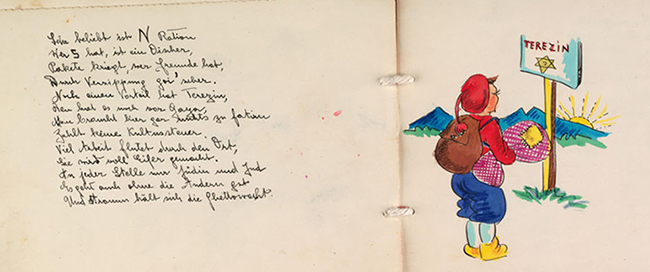
Jiri Bader's Bar Mitzvah Album
An Album from the Terezin Ghetto
format_quote

Dried leaves, a souvenir from Riga, that Zalman Levinson sent to his aunt, Agnes Hirschberg, before the war

Cloth patch like those sewn on the clothes of the children hidden in Chamonix

Regine (Rivka) Gartenlaub Paris, 1939.
Regina and her sister Dina were hidden by Georgette Cheverry during the war

Reflected image of Zalman Levinson, Riga, 1937
Zalman and his family were murdered in Riga in 1941

This doll belonged to Inge Liebe from Dresden, Germany, who was 5 when she was deported with her mother to Auschwitz, where they were both murdered

The Teddy Bear “Mishu”, Stella Knobel’s Best Friend

A doll’s crib built by Ycek-Josef Horonczyk for his daughter Francine while he was interned in the Beaune-la-Rolande camp

Petr Ginz (1928 - 1944). Street in Theresienstadt
Watercolor, ink and pencil on paper.
Born in Prague, Ginz was a multi-talented youth, who drew and wrote essays, short stories and poems from an early age. Following the German occupation of Czechoslovakia, he was expelled from school due to the racial laws. In 1942, he was deported to Terezin where he continued to draw and write. Together with friends in the youth barracks, Ginz edited and published the clandestine newspaper Vedem (We Are Leading). In the fall of 1944, he was deported to Auschwitz, where he was murdered immediately upon arrival. Read more >>>

The young boy in this photograph arrived in the Port of Haifa in 1945 with his brother after having been liberated from the Buchenwald camp

Lydia Hӧnig's personal album containing notes from family and friends from Novi Sad, 1940-1941
Lydia and her family fled to Budapest in 1942 and survived the Holocaust. Many of the family and friends who wrote dedications in the album perished in the Holocaust. See the album >>>

This doll belonged to Claudine Schwartz-Rudel was 7 years old when she fled from Paris to Southern France with her parents
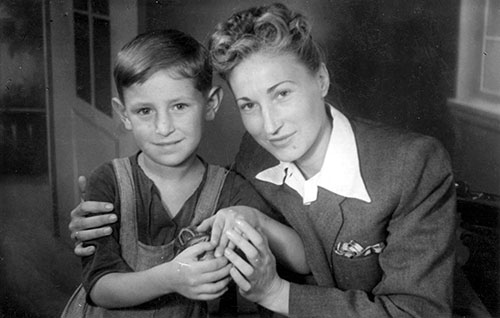
The Righteous Among the Nations Genowefa Majcher with the rescued Michael Rozenshein, summer 1947
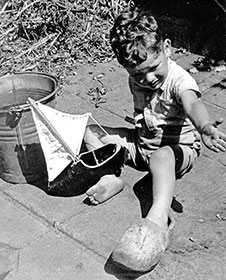
Lode Frank (pictured here) was rescued by the Schaafsma family in Holland
format_quote
I feel as if I am in a box. There is no air to breathe. Wherever you go you encounter a gate that hems you in... I feel that I have been robbed, my freedom is being robbed from me, my home, and the familiar Vilna streets I love so much. I have been cut off from all that is dear and precious to me. Yitskhok Rudashevski age 15

From left to right: Majer-Marcel Bulka, his brother Albert, and his friend, Alek Bergman, Izieu, summer 1943.
The Bulka brothers were both murdered at Auschwitz, Alek left the children’s home before the Gestapo raid, and survived the Holocaust.
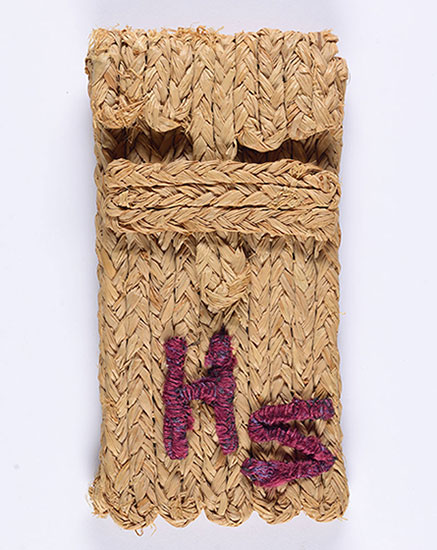
Raffia glasses case that Irma Schwartz made in the Gurs detainment camp, and sent to her son Heinz in Switzerland on the occasion of his Bar Mitzvah
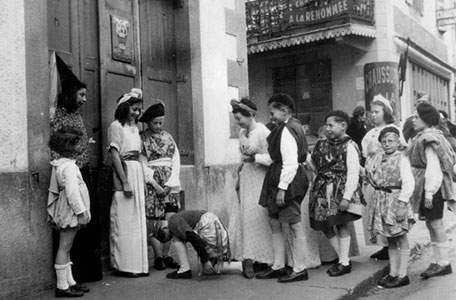
Children of the home in Chamonix dressed up for Mardi Gras, 1943-1944
Third from left: the girl dressed up as a princess is Nelly Einhorn (later Nurith Reubinoff). The children used to dress up and prepare plays. Very often they would rehearse in the streets near the children's home.
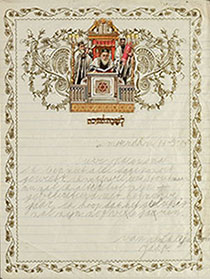
New Year card that 7-year-old Jacob Hijman Marcus wrote to his grandparents. Amsterdam, 19 September 1941
"Opa and Oma,
I wasn't a good boy every day. Sometimes I was naughty, but from now on I'll be a good boy all the time. Best wishes for the New Year. I hope that this year and many more years will be happy. From your grandson,
Jaap"
Jacob Hijman Marcus wrote these words to his grandparents in Amsterdam in 1941, on the eve of Rosh Hashana, the Jewish New Year. On 23 October 1944, ten-year-old Jacob was deported to his death in Auschwitz. His grandparents, mother and father all survived. Read more >>>
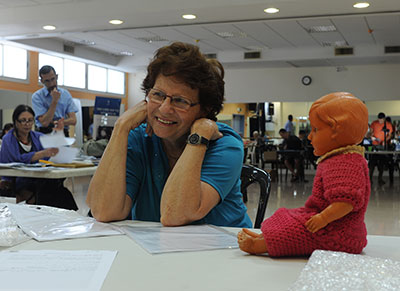
The Doll “Lala” (“Ilana”) that Vera Lifschitz Received in the Transit Camp in Karachi, India (today Pakistan)
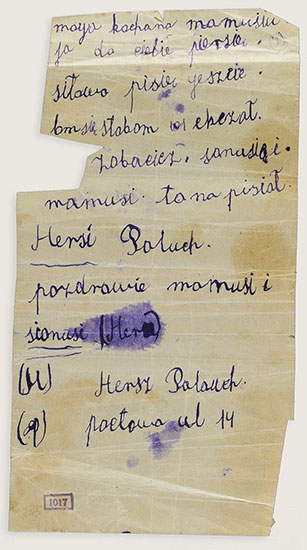
"My beloved mother, I am writing to you. I want to see you…"
A last letter to mother written by 13-year-old Hersch Paluch
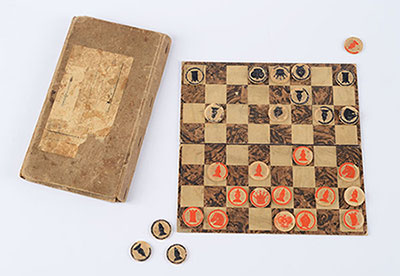
A chess game played by a young girl and boy in the Mogilev ghetto in Transnistria
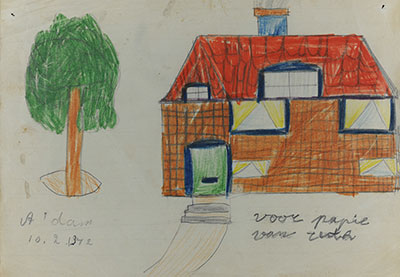
Picture drawn by 8 year old Ruth Jurgrau for her father Dov on 10 February 1942
Ruth survived the Holocaust as a child in hiding. Her mother Leah was deported to her death in Sobibor in 1943. Her father, Dov, was arrested, sent to Westerbork, and then to Auschwitz, where he was murdered. Read more >>>
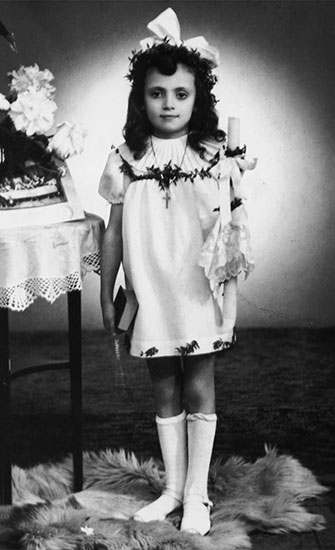
Janina Zimnowodzki-Nebel was hidden by a Polish family in Katowice from 1942 until the end of the war.
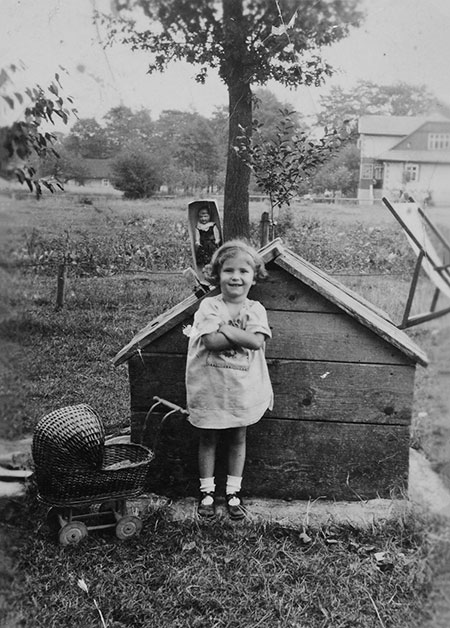
Jadzia Beitner (Yochit Mendelsohn) was born in 1933 in Katowice. At age 10, she was deported to the Oberalstadt labor camp in the Sudetenland.
She survived together with her mother and 2 sisters
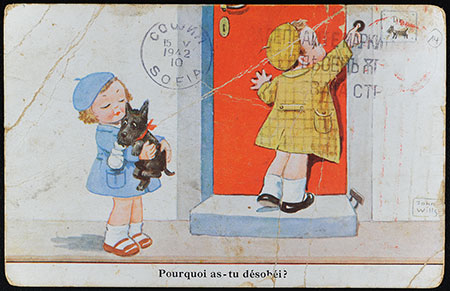
"I can hold my head up high"
Anne Meininger's last letter
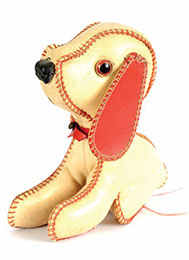
Betty Waterman’s toy dog that accompanied her into hiding
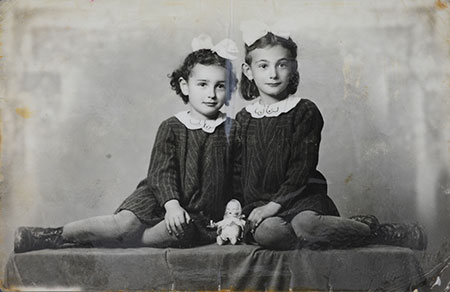
"Dear Daddy – we are well – goodbye". Sisters Suzan-Zsuzsa and Lili wrote these words in the last postcard that they sent to their father, Hugó Klein
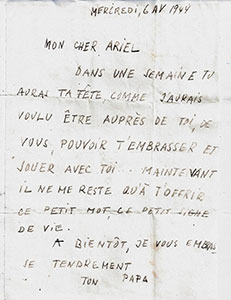
"In another week it will be your birthday. How I long to be with you, to kiss you and play with you…"
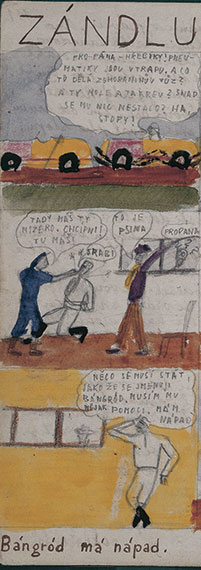
The newspaper Kamarad (Comrade), published in the Theresienstadt ghetto, contained descriptions of children's lives in the ghetto, as well as stories and poems

Wooden pencil box containing pencils and other writing utensils used by young Mira Kristianpolerow from Probuzna, Poland.
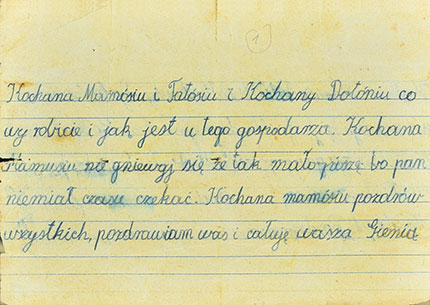
"Darling Mother, don't be upset that I'm writing so little, The man didn't have time to wait."
The Last Letter from 11-year-old Rivka Folkenflick
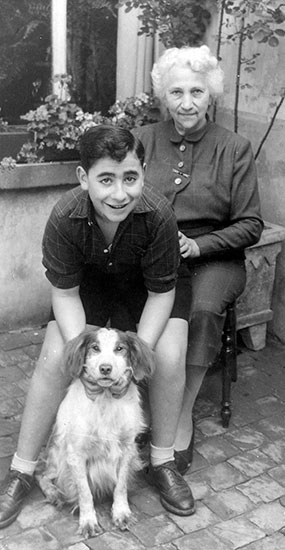
Jacques Heller together with his rescuer Maria Vandenberghen, July 1954
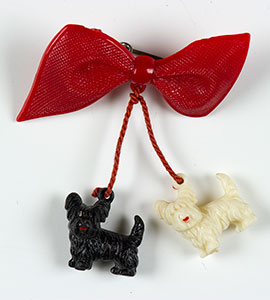
A brooch that Vera Bader received from her friend Eva Kozower in the Theresienstadt ghetto before Eva and her family were deported to Auschwitz and murdered.

A letter opener that served also as a penholder, made by Nissan Frenkel in Beaune-la-Rolande for his son Richard.
Nissan and his wife Esther Frenkel, and their son Richard, were murdered in Auschwitz
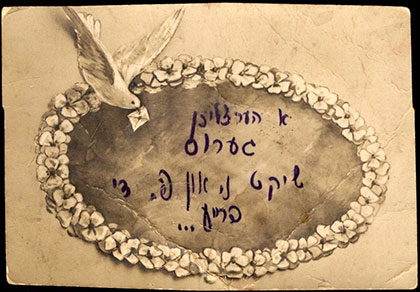
Last letter from a mother and sister
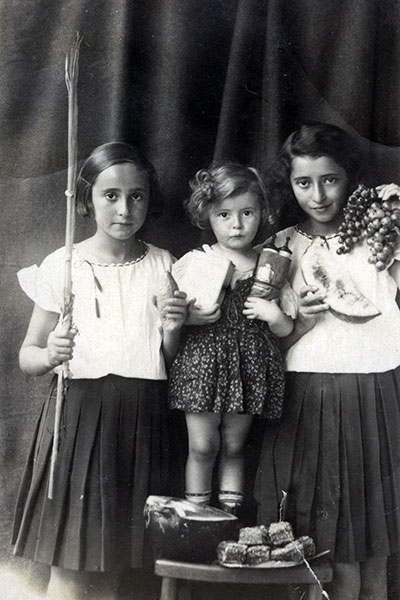
Prewar, Obertyn, Poland, Sonja Shulamit, Donia, and Esther Serger during the Sukkot holiday
Donia and Ester were murdered in the Holocaust
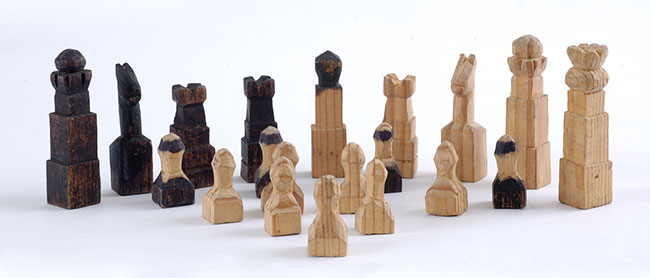
Chess pieces that Zigmund Stern carved while in hiding in Slovakia, 1944
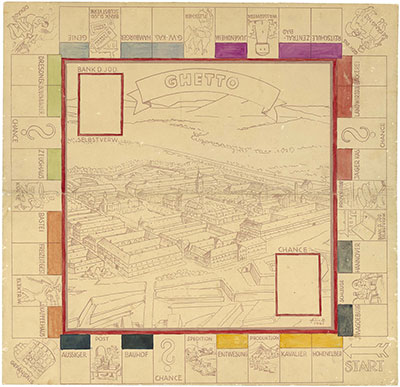
This Monopoly game was made in the graphics workshop in Theresienstadt as part of the ghetto’s underground activity
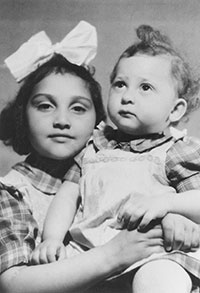
Eva Frommer-Farkash of Bratislava, Slovakia, lost her family in 1943 and was taken in by Ernest and Nellie Geier
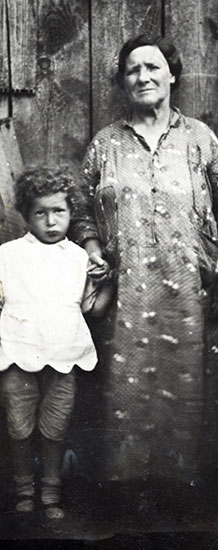
Hersch Paluch and his grandmother, Rachel Wajnrajter, Końskie, Poland, 1937
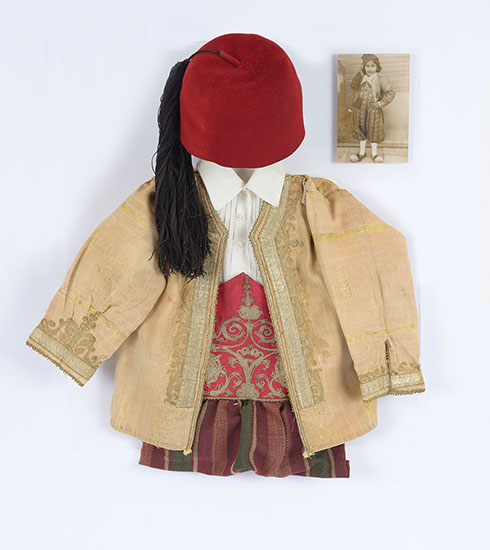
Purim costume of a Greek freedom fighter that belonged to Rachel-Sarah Osmo from Corfu, Greece
Rachel-Sarah perished in Auschwitz
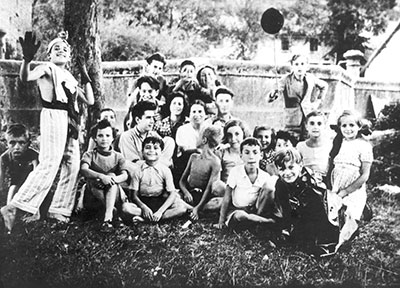
Group portrait of the children and staff, Izieu children's home, France, summer of 1943.
Most of the children in the photo were murdered
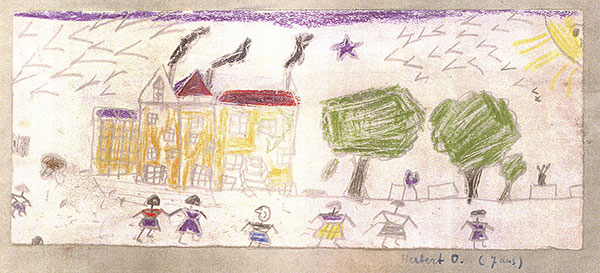
A drawing by Herbert Odenheimer (Ehud Loeb) from the period when he was hiding in a children's home in Chabannes after being removed from the Gurs detention camp
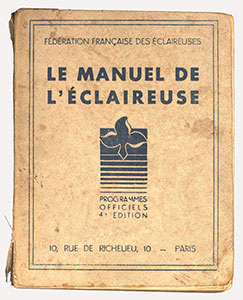
Scout handbook used in the children's home in Chamonix
The children's home in Chamonix provided a safe haven for dozens of children, most of them Jewish, from late 1942 until the liberation of France in the summer of 1944. The home was established by Juliette Vidal and Marinette Guy, later recognized as Righteous Among the Nations, with the assistance of the Jewish Scouts (EIF – Eclaireurs Israelites de France) and the OSE. Read more >>>
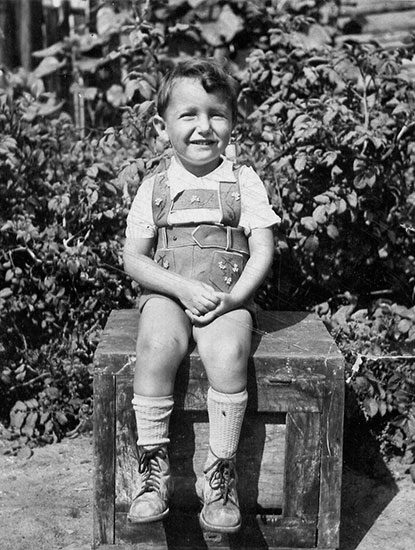
Moshe Rosenblum (pictured here), who along with his parents and grandparents were rescued by the Vobolevičius’ family
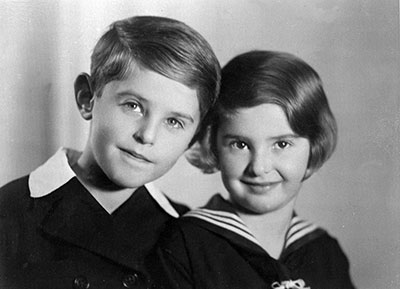
Petr Ginz with his sister, before the war
Born in Prague, Ginz was a multi-talented youth, who drew and wrote essays, short stories and poems from an early age. Following the German occupation of Czechoslovakia, he was expelled from school due to the racial laws. In 1942, he was deported to Terezin where he continued to draw and write. Together with friends in the youth barracks, Ginz edited and published the clandestine newspaper Vedem (We Are Leading). In the fall of 1944, he was deported to Auschwitz, where he was murdered immediately upon arrival.
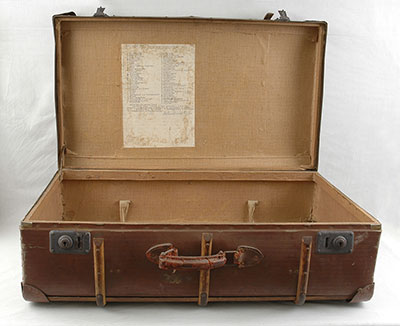
One of the suitcases used by Heinz Finke who left Germany on the Kindertransport to England

Berta school received this pencil from her classmates in the Christian school that she attended, to mark the holiday of Saint Barbara
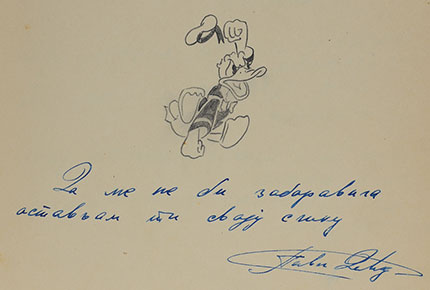
Page from Sarika Kalderon's autograph book, Belgrade, 1939
Sarika's grandfather Refael Majer was a rabbi, shochet (ritual slaughterer) and cantor in Belgrade. He and his wife Rivka had eight children, several of whom married and had children of their own. Almost the entire Majer family was wiped out in the Holocaust, including Sarika. Read more >>>
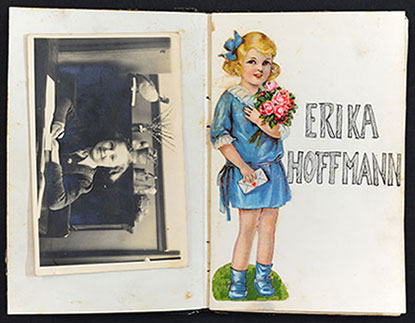
Erika Hoffmann's Personal Album
A Young Austrian Girl Hiding in Holland
Erika was born in 1931 in Vienna, Austria, and came to Holland with her family in 1939. In May 1943, a few months before her 12th birthday, Erika was deported to the Sobibor death camp, and murdered on arrival. See the album >>>

Dov Jurgrau and his daughter Ruth, the Netherlands, prewar
"Do you still remember the songs? I also sing them". Leah Jurgrau wrote these words to her 8-year-old daughter Ruth in her last letter from Westerbork on November 22, 1942. Leah was deported from Westerbork to her death in Sobibor in 1943. In July 1943 her husband Dov was deported to Auschwitz, where he was murdered in December. Ruth survived the Holocaust in hiding. At least 15 people were involved in Ruth's rescue and the attempt to save her parents. Most of Ruth's rescuers have been recognized as Righteous Among the Nations. In 1947 Ruth immigrated to Eretz Israel. Read more >>>
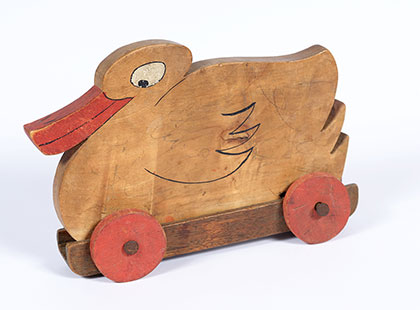
A hollow wooden duck that was used to smuggle documents during the Holocaust
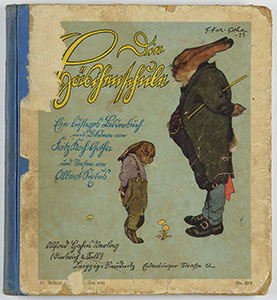
Children's books that belonged to Ruth Rosenberg, a child from Germany
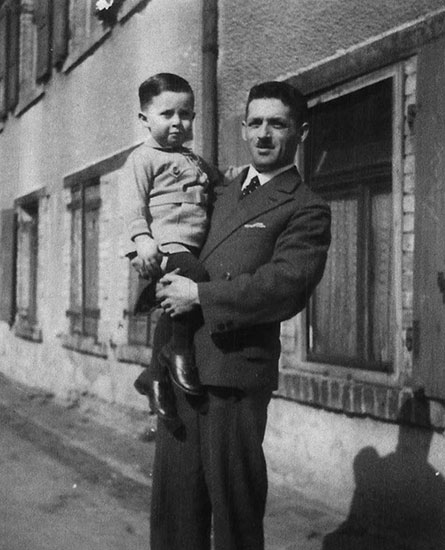
Herbert Odenheimer (Ehud Loeb) with his father Hugo in Buehl, Germany, before the war
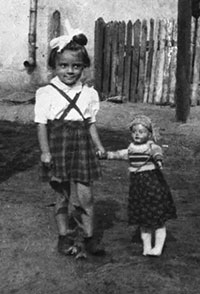
Ita Keller Lvov, Poland, 1943

Petr Ginz (1928 - 1944). Interior of Living Quarters in the Theresienstadt Ghetto
Watercolor, ink and pencil on paper.
Born in Prague, Ginz was a multi-talented youth, who drew and wrote essays, short stories and poems from an early age. Following the German occupation of Czechoslovakia, he was expelled from school due to the racial laws. In 1942, he was deported to Terezin where he continued to draw and write. Together with friends in the youth barracks, Ginz edited and published the clandestine newspaper Vedem (We Are Leading). In the fall of 1944, he was deported to Auschwitz, where he was murdered immediately upon arrival.
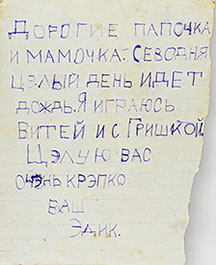
“Dear Mummy and Daddy… I also kiss and hug both of you very tight. Yours, Edik"
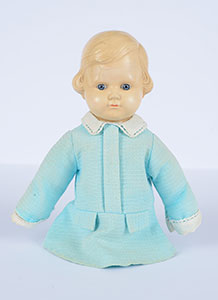
Doll belonged to Agatha Miriam Ressler from Slovakia
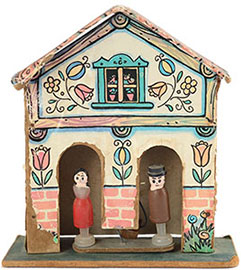
In the Debrecen ghetto, Hungary, Leah Burnstein made a dollhouse with dolls in the image of her parents, as a souvenir of the home from which they were deported
The dollhouse is part of the ready2print exhibition "Stars Without a Heaven. Children in the Holocaust" >>>
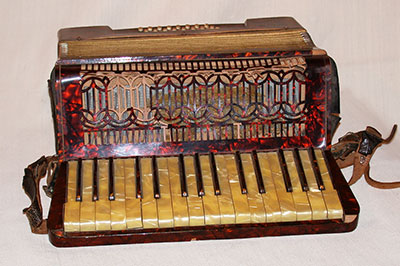
Accordion that Shabetai Shemi from Bitola (Monastir), Macedonia received as a gift for his Bar Mitzva.
The accordion was given to a friend for safekeeping when Shabetai was deported
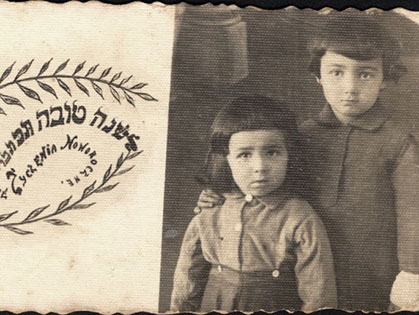
Druja, Poland, Meir Levitanus (the submitter) and his sister Chaya Miriam Marla, 1941
Meir and Chaya were photgraphed for a new year greeting card.
Chaya was murdered in Druja on 16 June 1942. Meir survived the Holocaust.
format_quote
May 30, 1944. [...] Dear diary, I don't want to die; I want to live even if it means that I'll be the only person here allowed to stay. I would wait for the end of the war in some cellar, or on the roof, or in some secret cranny. [...] Just as long as they didn't kill me, only that they should let me live. [...] I can't write anymore, dear diary, the tears run from my eyes Eva Heyman age 13
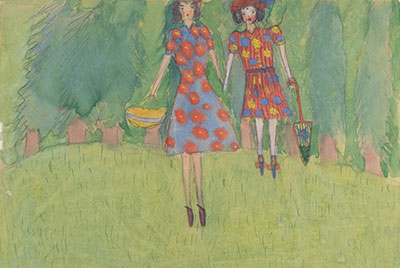
Nelly Toll "Girls in the Field, Lvov, 1943"
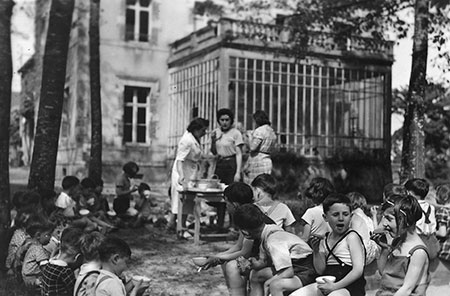
Herbert Odenheimer (Ehud Loeb) (front, with the crossed-over shoulder straps) at the children's home in Chabannes, 1941
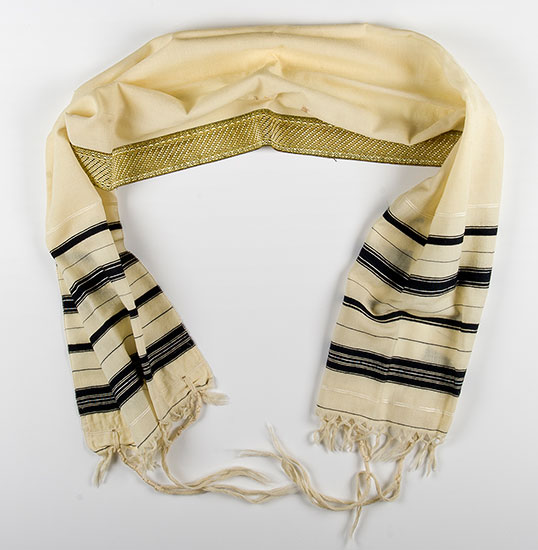
Prayer shawl Jiři Bader received for his Bar Mitzvah, celebrated in the Theresienstadt ghetto in 1944
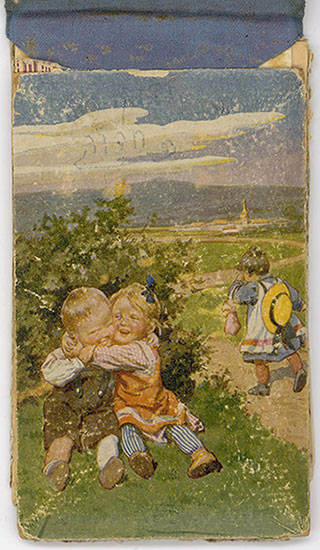
Franka Kleczewska’s Personal Album
Final Messages from the Lodz Ghetto
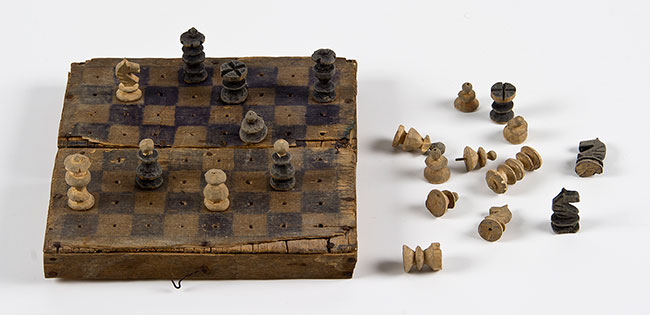
Chess set carved by Julius Druckman in the Obdovka ghetto, Transnistria, 1943

Norbert Kurzmann's Personal Album
One of the Tehran Children Survivors
format_quote
I did not cry. I thought: I'm Jewish. There is no place for me. I stood there until no one stood in front of the school. Only me. The new school year had begun. But not for me. Hannah Hershkowitz
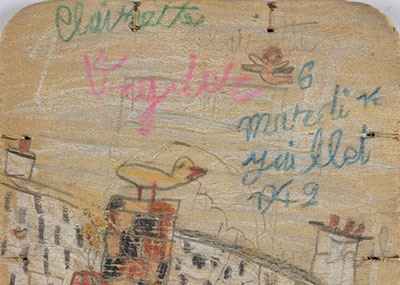
The drawing by Clairette Vigder with inscription “Tuesday, 14 July 1942”
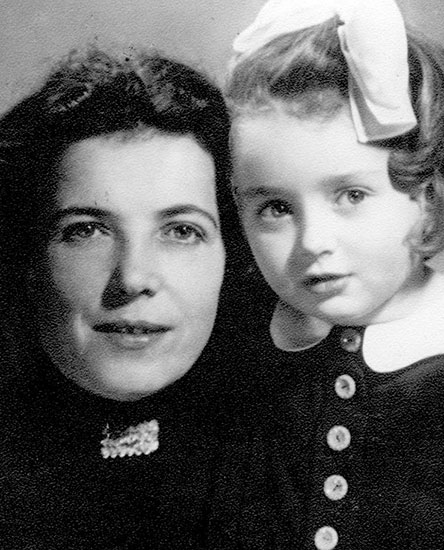
Shifra Jonisz with her rescuer Leokadia Jaromirska
Leokadia Jaromirska lived in the Warsaw suburb of Bialoleka. In October 1942 she took home the 8-month-old baby abandoned near the fence of a convent. As the Russians approached Leokadia was forced to evacuate. She took the child along and the two wandered from one place to another, constantly searching for food and for a place to sleep. In October 1945, 3 years after he had left her near the convent fence, Shifra's father managed to trace her. Read more >>>
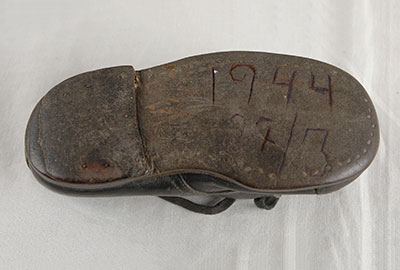
The baby shoe of Hinda Cohen, with the date of her deportation to the death camps carved into the sole by her father
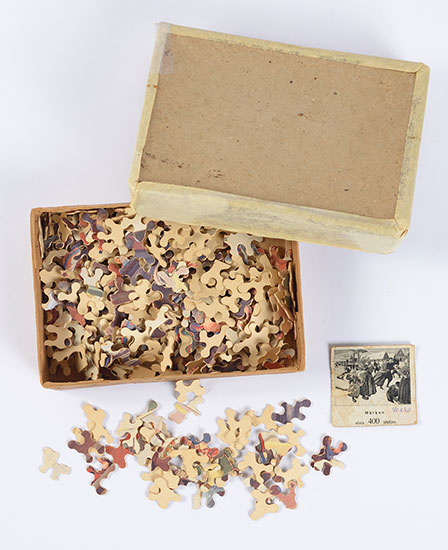
"Vanished" puzzle that belonged to Chana (Hendrika) Broer from Vught, the Netherlands
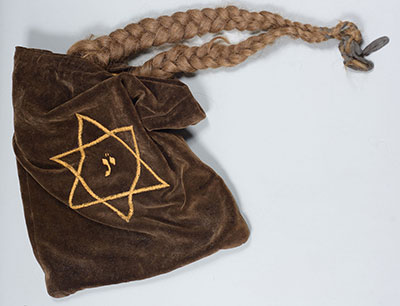
The braids of Lili Hirsch, who was deported with her family to Auschwitz and murdered
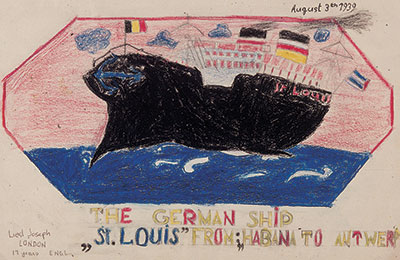
A drawing of the ship the St. Louis that 13 year old Liesel Joseph drew
The St. Louis left Hamburg, Germany in May, 1939, bound for Cuba. The boat was not allowed to dock in Cuba and wasn’t permitted entrance to the national waters of the U.S. or Canada and was forced to sail back to Europe. Most of the Jews who sailed on the St. Louis perished in the Holocaust. One of the few survivors was 13-years-old Liesel Joseph.
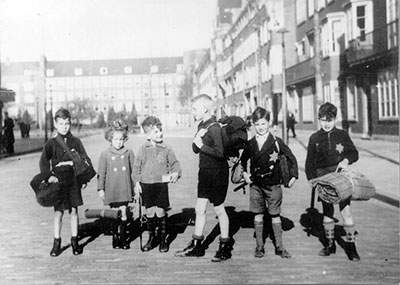
Fred Lessing (third from left) with other children on outing in Amsterdam
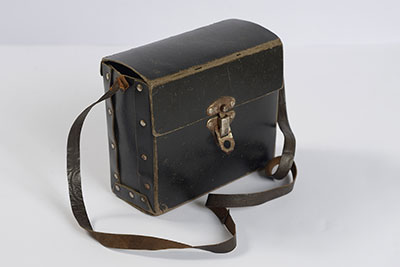
Lunch bag belonging to Tamara Podriacikas from Kovno, Lithuania
!["The giving of the statutes [Torah] was a one-time event, but they will be in force for as long as the world exists. The commandments are so sacred and immutable that we must aspire to observe them under any circumstances."](images/letters/bodenheimer-letter-s.jpg)
"The giving of the statutes [Torah] was a one-time event, but they will be in force for as long as the world exists. The commandments are so sacred and immutable that we must aspire to observe them under any circumstances."
Siegfried Bodenheimer wrote these words in his last letter to his son Ernst in the children's home in Montintin, three months before Ernst's Bar Mitzvah. Read more >>>
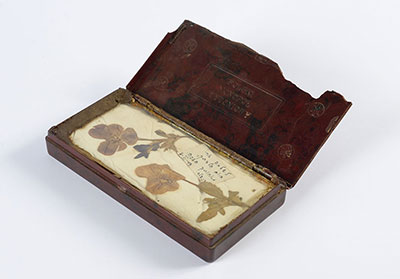
Box Holding Dried Flowers and a Dedication: "To my brother Shlomo on your Birthday, from your Sister Hadassah. Lindenfels, 7 June 1947"
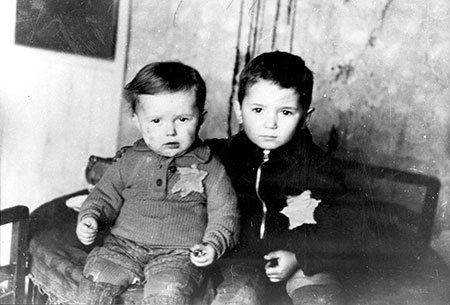
Avraham Rosenthal, aged 5 and his 2-year-old brother, Emanuel, February 1944, Kovno, Lithuania
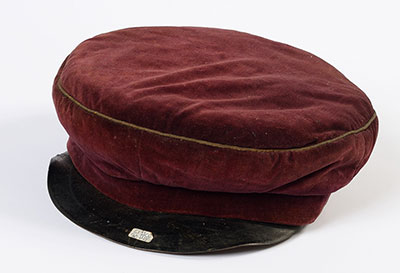
Shmuel Borstein's cap, part of the school uniform of the Jewish Real ("Reali") Gymnasium in Kovno, Lithuania
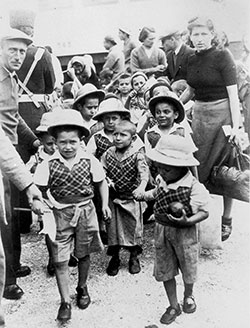
Mandatory Palestine, a group of five-year-old Tehran Children disembarking from a train, 18 February 1943
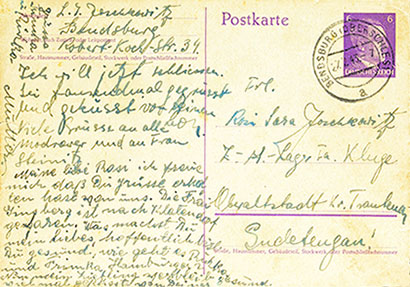
"What are you up to, my darling? Be well. Lots of kisses from your mother."
The Last Postcard from Berta Joschkowitz to her daughter Rosi
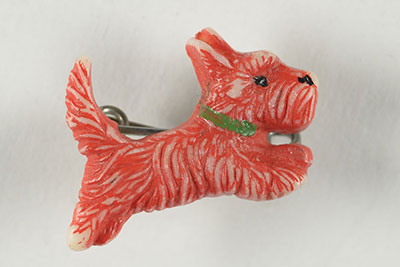
Brooch in the shape of a puppy that Anna Nussbaum received as a parting gift from her father when she left Vienna on a Kindertransport
format_quote
Today they came for my bicycle. I almost caused a big drama. You know, dear diary, I was awfully afraid just by the fact that the policemen came into the house. I know that policemen bring only trouble with them, wherever they go. [..] So, dear diary, I threw myself on the ground, held on to the back wheel of my bicycle, and shouted all sorts of things at the policemen: “Shame on you for taking away a bicycle from a girl! That’s robbery!” [..] One of the policemen was very annoyed and said: “All we need is for a Jewgirl to put on such a comedy when her bicycle is being taken away. No Jewkid is entitled to keep a bicycle anymore. The Jews aren’t entitled to bread, either; they shouldn’t guzzle everything, but leave the food for the soldiers Eva Heyman age 13
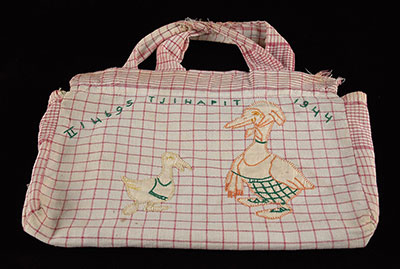
A bag sewn for Aleida-Chana Benninga by her mother and grandmother in camps set up by the Japanese in Indonesia
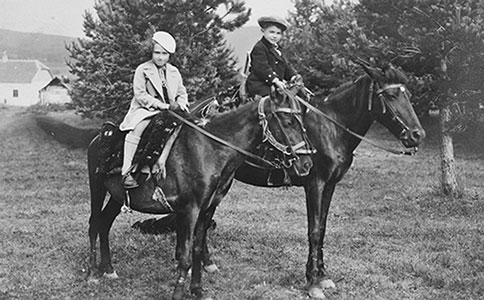
Sarika Kalderon and her brother Avraham-Faja, Belgrade, prewar
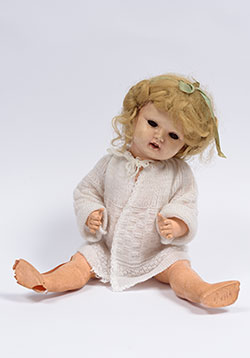
Throughout the war, Éva Modvál, born in 1936 in Transylvania, was accompanied by her doll Gerta
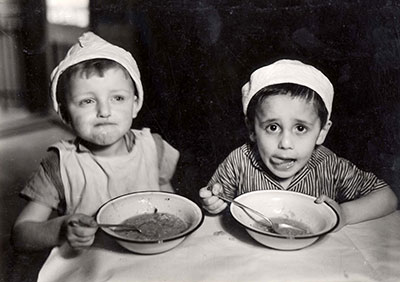
Children eating in the Orthodox Jewish home at 21 Twarda St., the Warsaw ghetto
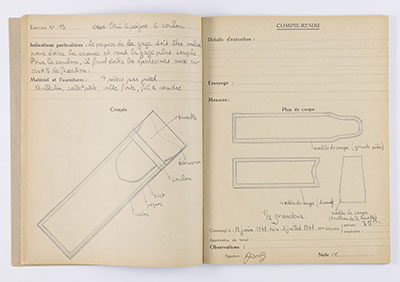
Stephan Lewy's notebook of sketches from the leather workshop run by Leon König in Chabannes
In the building adjacent to the Château de Chabannes, there was a leather workshop where the older children at the home were taught and employed. Felix Chevrier, director of the children's home, who was later recognized as Righteous Among the Nations, believed in equipping the children with skills to prepare them for life after the war. Read more >>>

While hiding In a cellar in the Warsaw ghetto, little Zofia played with Zuzia, the doll that her mother, Natalia Zajczyk, had made for her
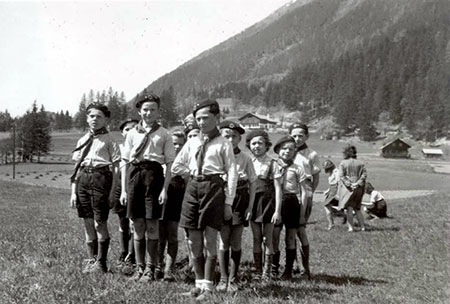
The children of the home in Chamonix in uniform during a Scout activity at the summer camp, Chamonix, 1943-1944
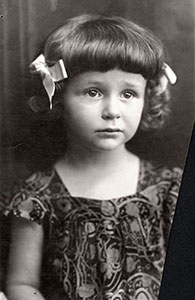
Valentina, daughter of Arkadi and Liudmila Zbar, was born in 1935 in Kharkov, Ukraine
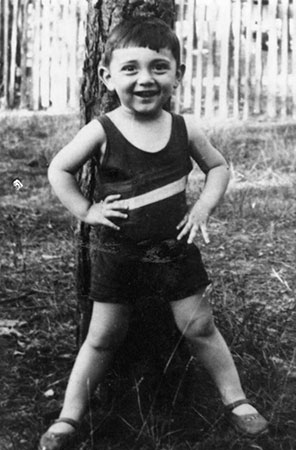
Yehiel Mintzberg, son of Abek (Abba) and Miriam Mintzberg, from Radom, Poland

"I hope that you will be able to stay with your foster parents, who are so good to you, until we return. It is comforting for us to know that at least you are safe."
Johanna Rosenbaum wrote these words in her last letter from her incarceration in Neede, the Netherlands, to her infant daughter Betty, who was living in hiding in Eibergen. Betty survived. Her parents Johanna and Ephraim, and her baby brother Izaäk Michel Max (Maxje), were murdered during the Shoah. Read more >>>

Rosi Joschkowitz (on the left) and the neighbors' daughter Shulamit Gottlieb. Nordhausen, Germany, 1938
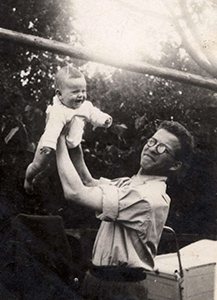
Moshe Manela and his daughter, Guta
Moshe Manela was born in the town of Kielce, Poland in 1908. He married Bluma Citron, and their daughter, Guta, was born in 1937. All three were murdered in Treblinka in 1942 – Moshe was 34, his wife Bluma 33, and Guta was just five years old.
The Pages of Testimony in their memory and the photograph were submitted to Yad Vashem by Arieh Citron-Hadari, Moshe's brother-in-law and Guta's Uncle.
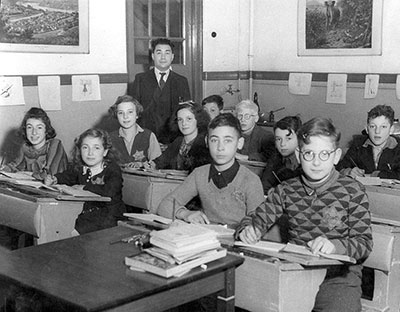
Class photograph of Jewish pupils with their teacher Mozes Goubitz, Amsterdam, the Netherlands
This photograph is part of an album documenting life and work in the Jewish Quarter of Amsterdam during the German occupation. The work was commissioned by J. Brandon, the secretary of the Jewish Council, in May 1941, and consists of 116 photographs taken over a two-month period. Most of the images depict Jewish residents.

Wooden pencil box containing pencils and other writing utensils used by young Mira Kristianpolerow from Probuzna, Poland.

Shmuel Borstein's cap, part of the school uniform of the Jewish Real ("Reali") Gymnasium in Kovno, Lithuania

Berta school received this pencil from her classmates in the Christian school that she attended, to mark the holiday of Saint Barbara
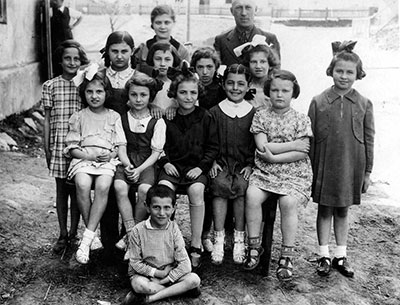
1st grade end-of-year photograph at the "Tarbut" school, Zborow, Poland, 1939, just before the outbreak of the war
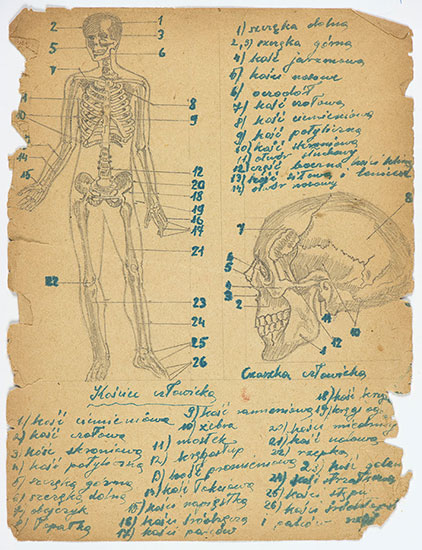
Drawings copied from an anatomy textbook by young Kuba (Jack) Jaget while in hiding
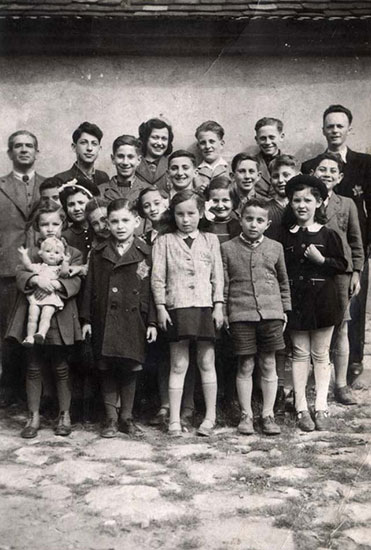
Vera and Jiri Bader with pupils and teachers at the Jewish school where they studied during the period of the Nazi occupation in Kyjov, Czechoslovakia

School badge belonging to Alina Landau, student at the Jewish girls' high school in Krakow, Poland
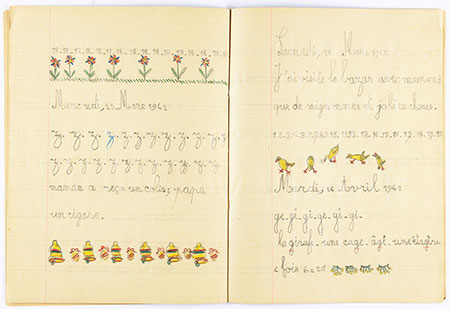
Notebook used by Clairette Vigder to practice her handwriting during the war years
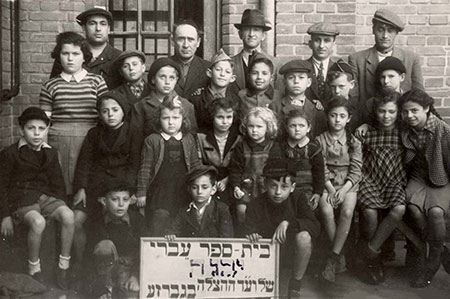
The "Yavne" Hebrew school run by the Rescue Committee at the Gabersee DP camp, Wasserburg, Germany, 27.4.1946
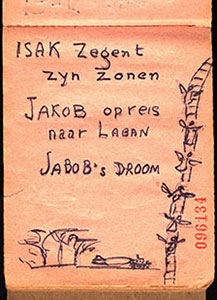
"Jacob's Dream", as drawn by Eliezer Dasberg for his young daughter Dina in a notebook in the Bergen-Belsen camp
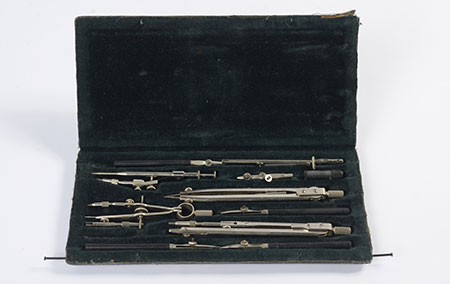
Drafting tools used by Sava Prahy in school in Donetsk, Ukraine before the war
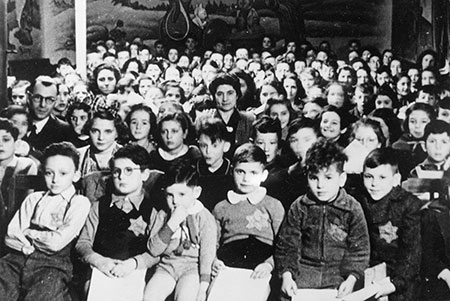
Fred Lessing and classmates in Amsterdam, 1942
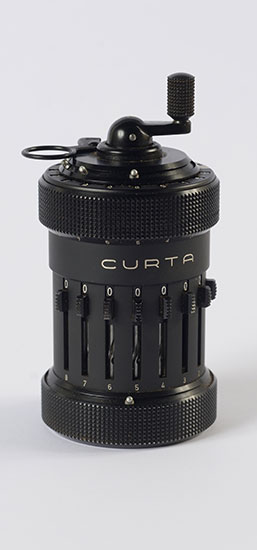
The "Curta", a hand-held mechanical calculator that is able to calculate basic arithmetic functions, was completed by a prisoner in Buchenwald
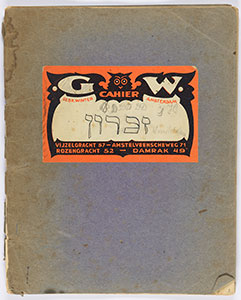
Jewish studies notebook belonging to Nachman Scheinowitz, the Westerbork camp, Holland
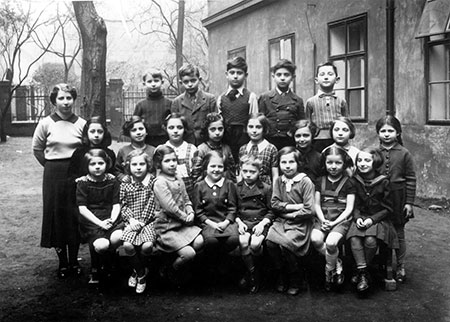
2nd grade pupils at the Jewish school, Prague, Czechoslovakia, 1937
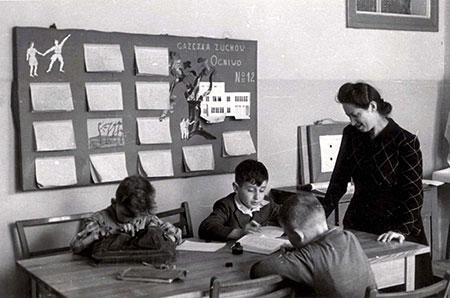
Students and their teacher Franciszka Oliwa in a classroom at the children's home in Otwock, postwar
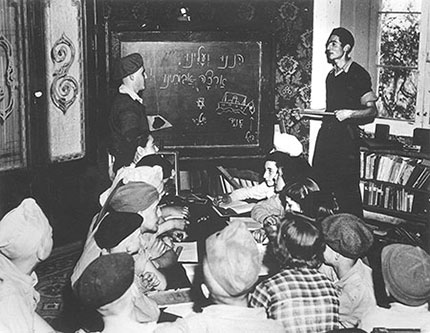
A Jewish Brigade soldier teaches Hebrew in the DP camp in Bari, Italy, 1944
The first Hachshara (pioneer training) camp established by soldiers from Eretz Israel in Bari was “Rishonim”. The Bari camp housed both Jews and non-Jews. In July 1947, there were some 780 Jews living there. To read more about daily life in DP camps and Hachsharot in Italy, click here >>>
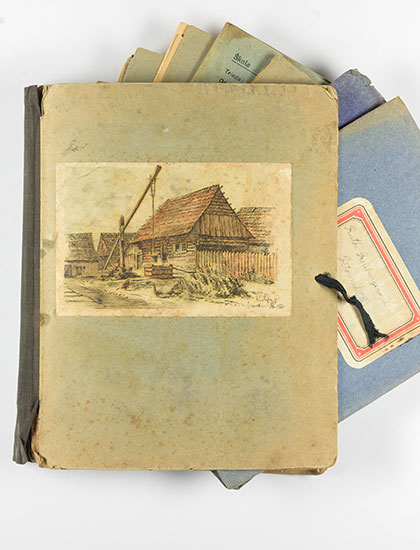
Folder of notebooks belonging to Ruth Pressburger of Bratislava, who was murdered during the Holocaust
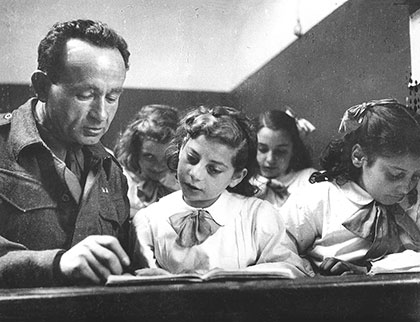
A soldier from Eretz Israel (Mandatory Palestine) serving in the British Army teaches Jewish children Hebrew in a camp in Italy after the war
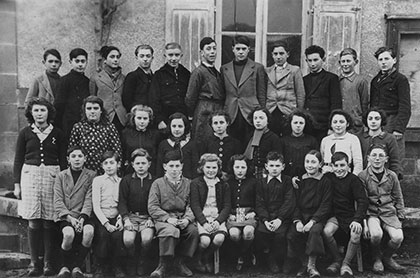
Class photo of students at the Ecole Saint-Pierre-de-Fursac, a school attended by Jewish refugee children living at the Chabannes children's home, as well as those from the village
Pictured: Pierre Lafaye; unknown; Renaud; Andre Dubois; Margot Weinberg; Lavinet; Andre Lelong; Kostia Sotnikov; Paulette Leblanc; Marcelle Fedon; Grosset; Irene Clement; Jeanne Luguet; Paulette Legris; Gisele Brunetaud; Ginette Chanliat; Mamet; Georges Loeffler; Norbert Bikales; Michel Razymovsky; Madeleine Boramier; Madeleine Basset; Anatole Zylberstein.
To read more about the Chabannes children's home, click here >>>


